Strategic Leadership Management: Theories, Application & Impact
VerifiedAdded on 2023/06/14
|9
|1980
|468
Report
AI Summary
This report provides an overview of strategic leadership management, focusing on the application of various management theories and leadership styles to achieve organizational objectives. It examines the evolution of work in the 21st century, highlighting the impact of technological advancements and alternative working patterns. The report discusses classical, human relations, and modern management theories, alongside different leadership styles such as transformational, transactional, democratic, autocratic, and laissez-faire. It further explores strategic concepts like situational and contingency strategies, and Porter's Five Forces, with a specific focus on navigating challenges posed by the COVID-19 pandemic and lockdown. The report concludes by emphasizing the importance of strategic leadership in adapting to changing environments and achieving organizational goals.
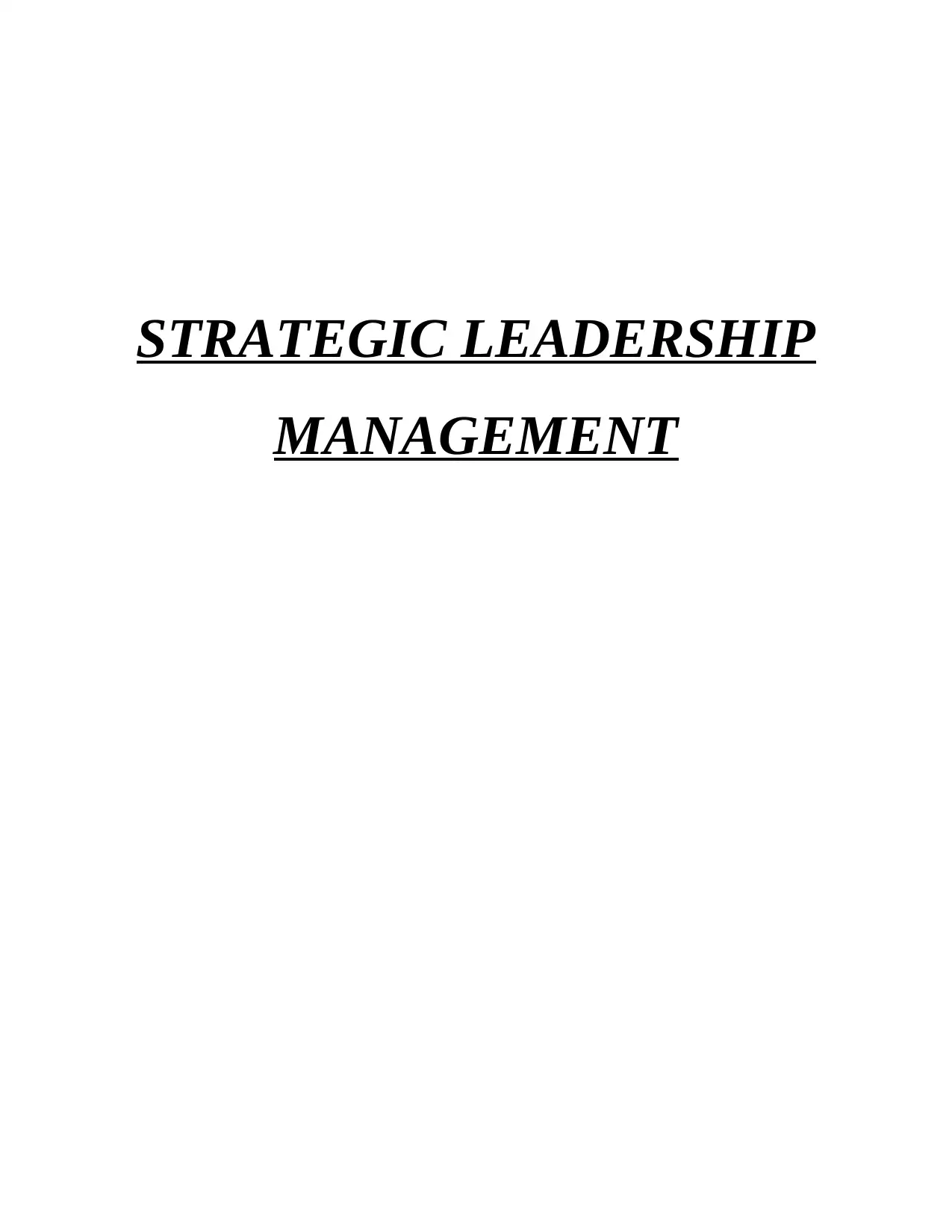
STRATEGIC LEADERSHIP
MANAGEMENT
MANAGEMENT
Paraphrase This Document
Need a fresh take? Get an instant paraphrase of this document with our AI Paraphraser

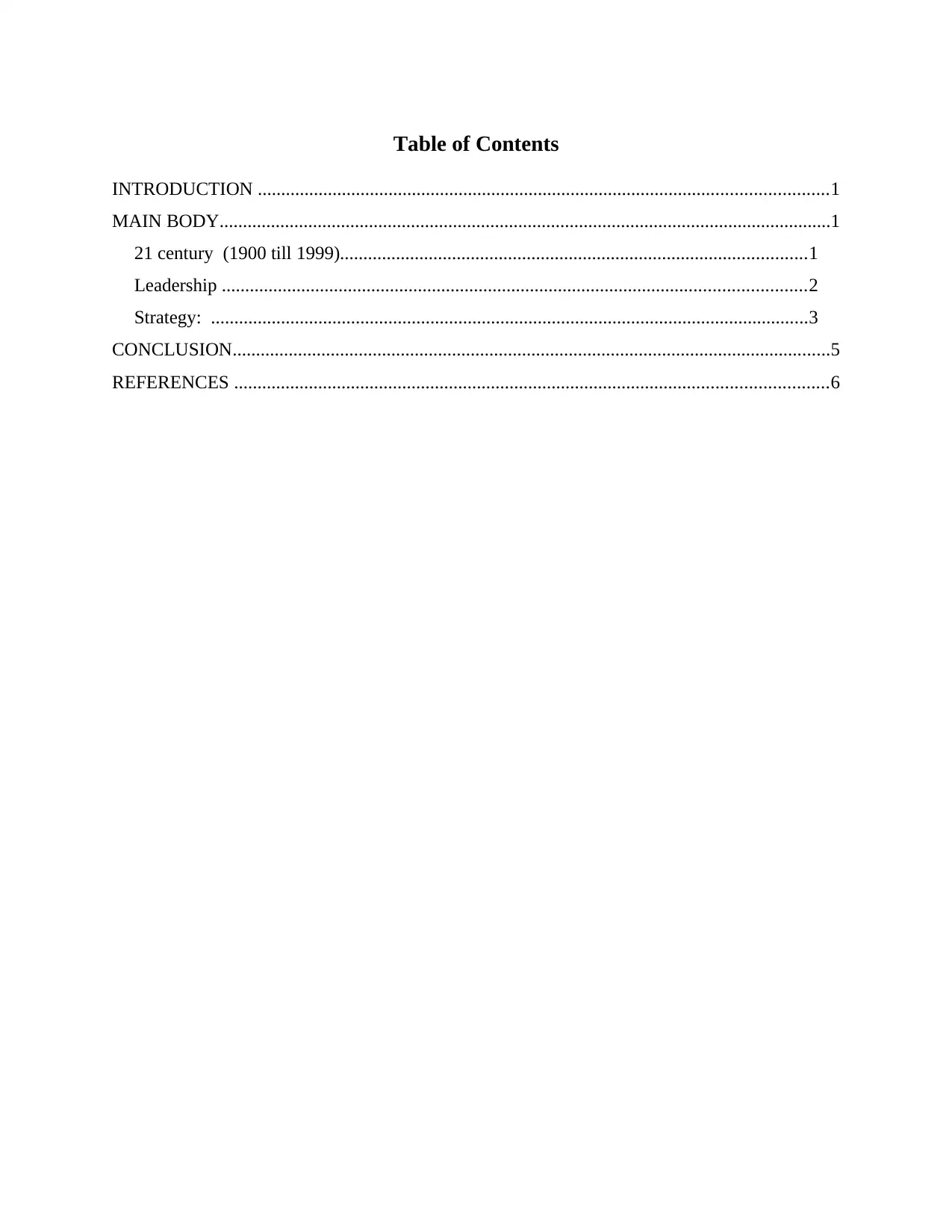
Table of Contents
INTRODUCTION ..........................................................................................................................1
MAIN BODY...................................................................................................................................1
21 century (1900 till 1999)....................................................................................................1
Leadership .............................................................................................................................2
Strategy: ................................................................................................................................3
CONCLUSION................................................................................................................................5
REFERENCES ...............................................................................................................................6
INTRODUCTION ..........................................................................................................................1
MAIN BODY...................................................................................................................................1
21 century (1900 till 1999)....................................................................................................1
Leadership .............................................................................................................................2
Strategy: ................................................................................................................................3
CONCLUSION................................................................................................................................5
REFERENCES ...............................................................................................................................6
⊘ This is a preview!⊘
Do you want full access?
Subscribe today to unlock all pages.

Trusted by 1+ million students worldwide
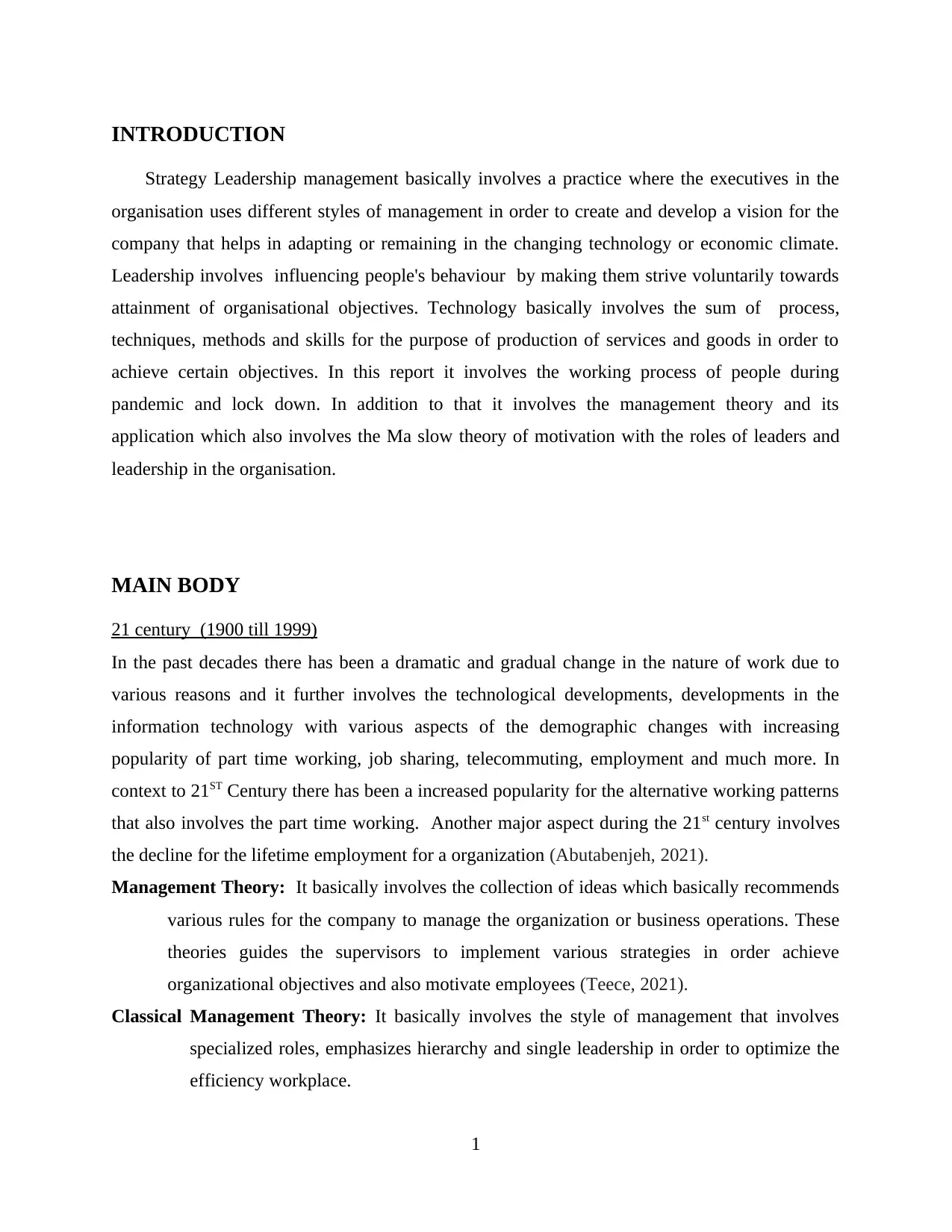
INTRODUCTION
Strategy Leadership management basically involves a practice where the executives in the
organisation uses different styles of management in order to create and develop a vision for the
company that helps in adapting or remaining in the changing technology or economic climate.
Leadership involves influencing people's behaviour by making them strive voluntarily towards
attainment of organisational objectives. Technology basically involves the sum of process,
techniques, methods and skills for the purpose of production of services and goods in order to
achieve certain objectives. In this report it involves the working process of people during
pandemic and lock down. In addition to that it involves the management theory and its
application which also involves the Ma slow theory of motivation with the roles of leaders and
leadership in the organisation.
MAIN BODY
21 century (1900 till 1999)
In the past decades there has been a dramatic and gradual change in the nature of work due to
various reasons and it further involves the technological developments, developments in the
information technology with various aspects of the demographic changes with increasing
popularity of part time working, job sharing, telecommuting, employment and much more. In
context to 21ST Century there has been a increased popularity for the alternative working patterns
that also involves the part time working. Another major aspect during the 21st century involves
the decline for the lifetime employment for a organization (Abutabenjeh, 2021).
Management Theory: It basically involves the collection of ideas which basically recommends
various rules for the company to manage the organization or business operations. These
theories guides the supervisors to implement various strategies in order achieve
organizational objectives and also motivate employees (Teece, 2021).
Classical Management Theory: It basically involves the style of management that involves
specialized roles, emphasizes hierarchy and single leadership in order to optimize the
efficiency workplace.
1
Strategy Leadership management basically involves a practice where the executives in the
organisation uses different styles of management in order to create and develop a vision for the
company that helps in adapting or remaining in the changing technology or economic climate.
Leadership involves influencing people's behaviour by making them strive voluntarily towards
attainment of organisational objectives. Technology basically involves the sum of process,
techniques, methods and skills for the purpose of production of services and goods in order to
achieve certain objectives. In this report it involves the working process of people during
pandemic and lock down. In addition to that it involves the management theory and its
application which also involves the Ma slow theory of motivation with the roles of leaders and
leadership in the organisation.
MAIN BODY
21 century (1900 till 1999)
In the past decades there has been a dramatic and gradual change in the nature of work due to
various reasons and it further involves the technological developments, developments in the
information technology with various aspects of the demographic changes with increasing
popularity of part time working, job sharing, telecommuting, employment and much more. In
context to 21ST Century there has been a increased popularity for the alternative working patterns
that also involves the part time working. Another major aspect during the 21st century involves
the decline for the lifetime employment for a organization (Abutabenjeh, 2021).
Management Theory: It basically involves the collection of ideas which basically recommends
various rules for the company to manage the organization or business operations. These
theories guides the supervisors to implement various strategies in order achieve
organizational objectives and also motivate employees (Teece, 2021).
Classical Management Theory: It basically involves the style of management that involves
specialized roles, emphasizes hierarchy and single leadership in order to optimize the
efficiency workplace.
1
Paraphrase This Document
Need a fresh take? Get an instant paraphrase of this document with our AI Paraphraser
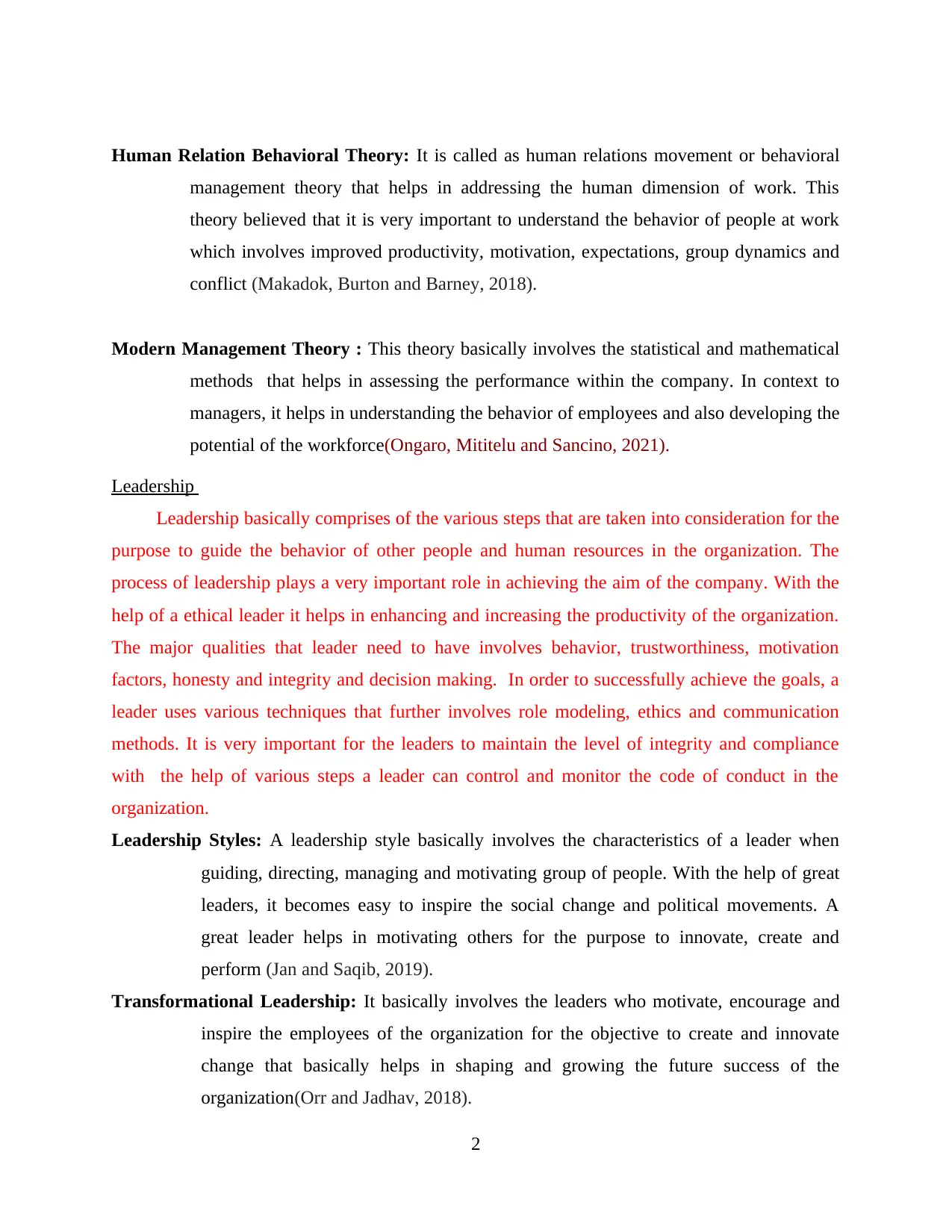
Human Relation Behavioral Theory: It is called as human relations movement or behavioral
management theory that helps in addressing the human dimension of work. This
theory believed that it is very important to understand the behavior of people at work
which involves improved productivity, motivation, expectations, group dynamics and
conflict (Makadok, Burton and Barney, 2018).
Modern Management Theory : This theory basically involves the statistical and mathematical
methods that helps in assessing the performance within the company. In context to
managers, it helps in understanding the behavior of employees and also developing the
potential of the workforce(Ongaro, Mititelu and Sancino, 2021).
Leadership
Leadership basically comprises of the various steps that are taken into consideration for the
purpose to guide the behavior of other people and human resources in the organization. The
process of leadership plays a very important role in achieving the aim of the company. With the
help of a ethical leader it helps in enhancing and increasing the productivity of the organization.
The major qualities that leader need to have involves behavior, trustworthiness, motivation
factors, honesty and integrity and decision making. In order to successfully achieve the goals, a
leader uses various techniques that further involves role modeling, ethics and communication
methods. It is very important for the leaders to maintain the level of integrity and compliance
with the help of various steps a leader can control and monitor the code of conduct in the
organization.
Leadership Styles: A leadership style basically involves the characteristics of a leader when
guiding, directing, managing and motivating group of people. With the help of great
leaders, it becomes easy to inspire the social change and political movements. A
great leader helps in motivating others for the purpose to innovate, create and
perform (Jan and Saqib, 2019).
Transformational Leadership: It basically involves the leaders who motivate, encourage and
inspire the employees of the organization for the objective to create and innovate
change that basically helps in shaping and growing the future success of the
organization(Orr and Jadhav, 2018).
2
management theory that helps in addressing the human dimension of work. This
theory believed that it is very important to understand the behavior of people at work
which involves improved productivity, motivation, expectations, group dynamics and
conflict (Makadok, Burton and Barney, 2018).
Modern Management Theory : This theory basically involves the statistical and mathematical
methods that helps in assessing the performance within the company. In context to
managers, it helps in understanding the behavior of employees and also developing the
potential of the workforce(Ongaro, Mititelu and Sancino, 2021).
Leadership
Leadership basically comprises of the various steps that are taken into consideration for the
purpose to guide the behavior of other people and human resources in the organization. The
process of leadership plays a very important role in achieving the aim of the company. With the
help of a ethical leader it helps in enhancing and increasing the productivity of the organization.
The major qualities that leader need to have involves behavior, trustworthiness, motivation
factors, honesty and integrity and decision making. In order to successfully achieve the goals, a
leader uses various techniques that further involves role modeling, ethics and communication
methods. It is very important for the leaders to maintain the level of integrity and compliance
with the help of various steps a leader can control and monitor the code of conduct in the
organization.
Leadership Styles: A leadership style basically involves the characteristics of a leader when
guiding, directing, managing and motivating group of people. With the help of great
leaders, it becomes easy to inspire the social change and political movements. A
great leader helps in motivating others for the purpose to innovate, create and
perform (Jan and Saqib, 2019).
Transformational Leadership: It basically involves the leaders who motivate, encourage and
inspire the employees of the organization for the objective to create and innovate
change that basically helps in shaping and growing the future success of the
organization(Orr and Jadhav, 2018).
2
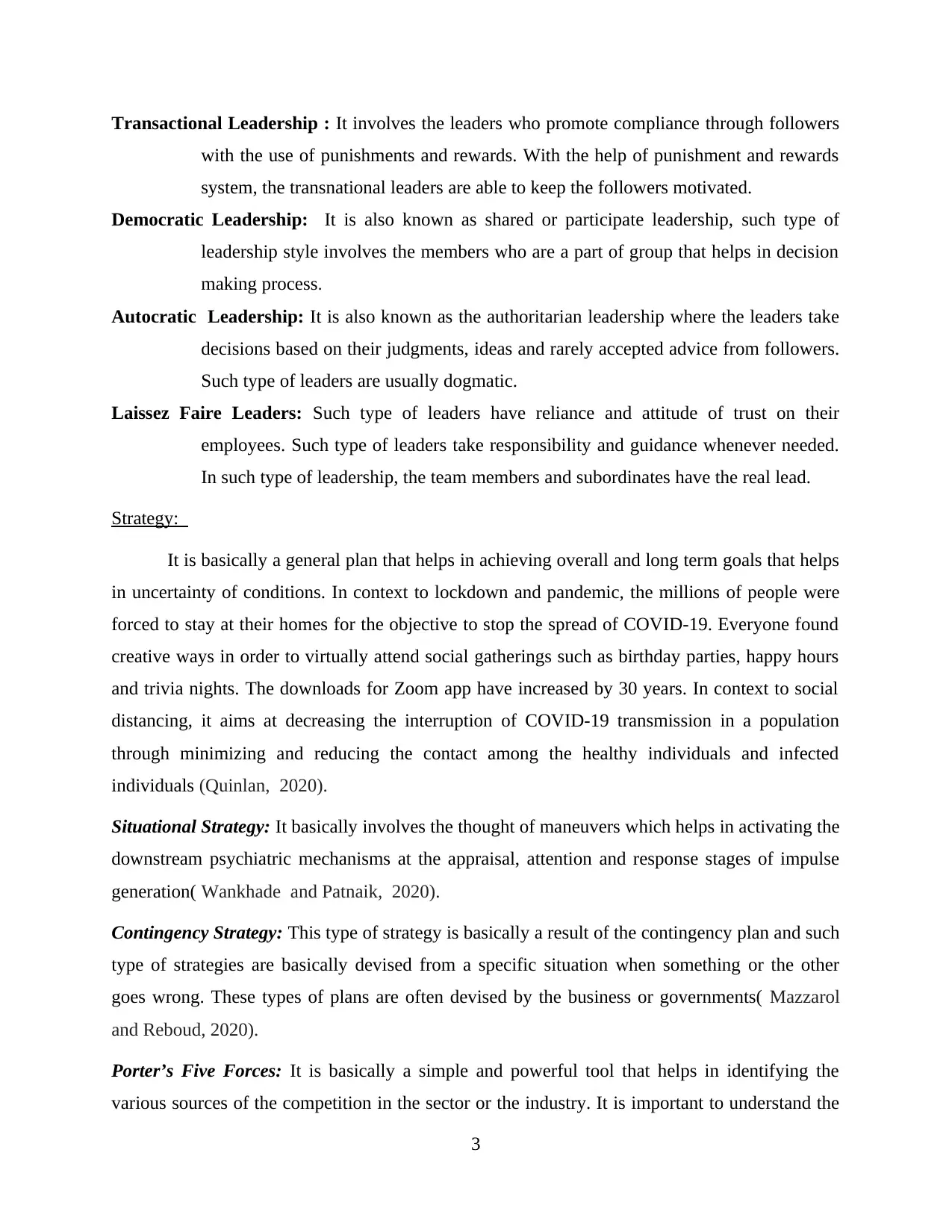
Transactional Leadership : It involves the leaders who promote compliance through followers
with the use of punishments and rewards. With the help of punishment and rewards
system, the transnational leaders are able to keep the followers motivated.
Democratic Leadership: It is also known as shared or participate leadership, such type of
leadership style involves the members who are a part of group that helps in decision
making process.
Autocratic Leadership: It is also known as the authoritarian leadership where the leaders take
decisions based on their judgments, ideas and rarely accepted advice from followers.
Such type of leaders are usually dogmatic.
Laissez Faire Leaders: Such type of leaders have reliance and attitude of trust on their
employees. Such type of leaders take responsibility and guidance whenever needed.
In such type of leadership, the team members and subordinates have the real lead.
Strategy:
It is basically a general plan that helps in achieving overall and long term goals that helps
in uncertainty of conditions. In context to lockdown and pandemic, the millions of people were
forced to stay at their homes for the objective to stop the spread of COVID-19. Everyone found
creative ways in order to virtually attend social gatherings such as birthday parties, happy hours
and trivia nights. The downloads for Zoom app have increased by 30 years. In context to social
distancing, it aims at decreasing the interruption of COVID-19 transmission in a population
through minimizing and reducing the contact among the healthy individuals and infected
individuals (Quinlan, 2020).
Situational Strategy: It basically involves the thought of maneuvers which helps in activating the
downstream psychiatric mechanisms at the appraisal, attention and response stages of impulse
generation( Wankhade and Patnaik, 2020).
Contingency Strategy: This type of strategy is basically a result of the contingency plan and such
type of strategies are basically devised from a specific situation when something or the other
goes wrong. These types of plans are often devised by the business or governments( Mazzarol
and Reboud, 2020).
Porter’s Five Forces: It is basically a simple and powerful tool that helps in identifying the
various sources of the competition in the sector or the industry. It is important to understand the
3
with the use of punishments and rewards. With the help of punishment and rewards
system, the transnational leaders are able to keep the followers motivated.
Democratic Leadership: It is also known as shared or participate leadership, such type of
leadership style involves the members who are a part of group that helps in decision
making process.
Autocratic Leadership: It is also known as the authoritarian leadership where the leaders take
decisions based on their judgments, ideas and rarely accepted advice from followers.
Such type of leaders are usually dogmatic.
Laissez Faire Leaders: Such type of leaders have reliance and attitude of trust on their
employees. Such type of leaders take responsibility and guidance whenever needed.
In such type of leadership, the team members and subordinates have the real lead.
Strategy:
It is basically a general plan that helps in achieving overall and long term goals that helps
in uncertainty of conditions. In context to lockdown and pandemic, the millions of people were
forced to stay at their homes for the objective to stop the spread of COVID-19. Everyone found
creative ways in order to virtually attend social gatherings such as birthday parties, happy hours
and trivia nights. The downloads for Zoom app have increased by 30 years. In context to social
distancing, it aims at decreasing the interruption of COVID-19 transmission in a population
through minimizing and reducing the contact among the healthy individuals and infected
individuals (Quinlan, 2020).
Situational Strategy: It basically involves the thought of maneuvers which helps in activating the
downstream psychiatric mechanisms at the appraisal, attention and response stages of impulse
generation( Wankhade and Patnaik, 2020).
Contingency Strategy: This type of strategy is basically a result of the contingency plan and such
type of strategies are basically devised from a specific situation when something or the other
goes wrong. These types of plans are often devised by the business or governments( Mazzarol
and Reboud, 2020).
Porter’s Five Forces: It is basically a simple and powerful tool that helps in identifying the
various sources of the competition in the sector or the industry. It is important to understand the
3
⊘ This is a preview!⊘
Do you want full access?
Subscribe today to unlock all pages.

Trusted by 1+ million students worldwide
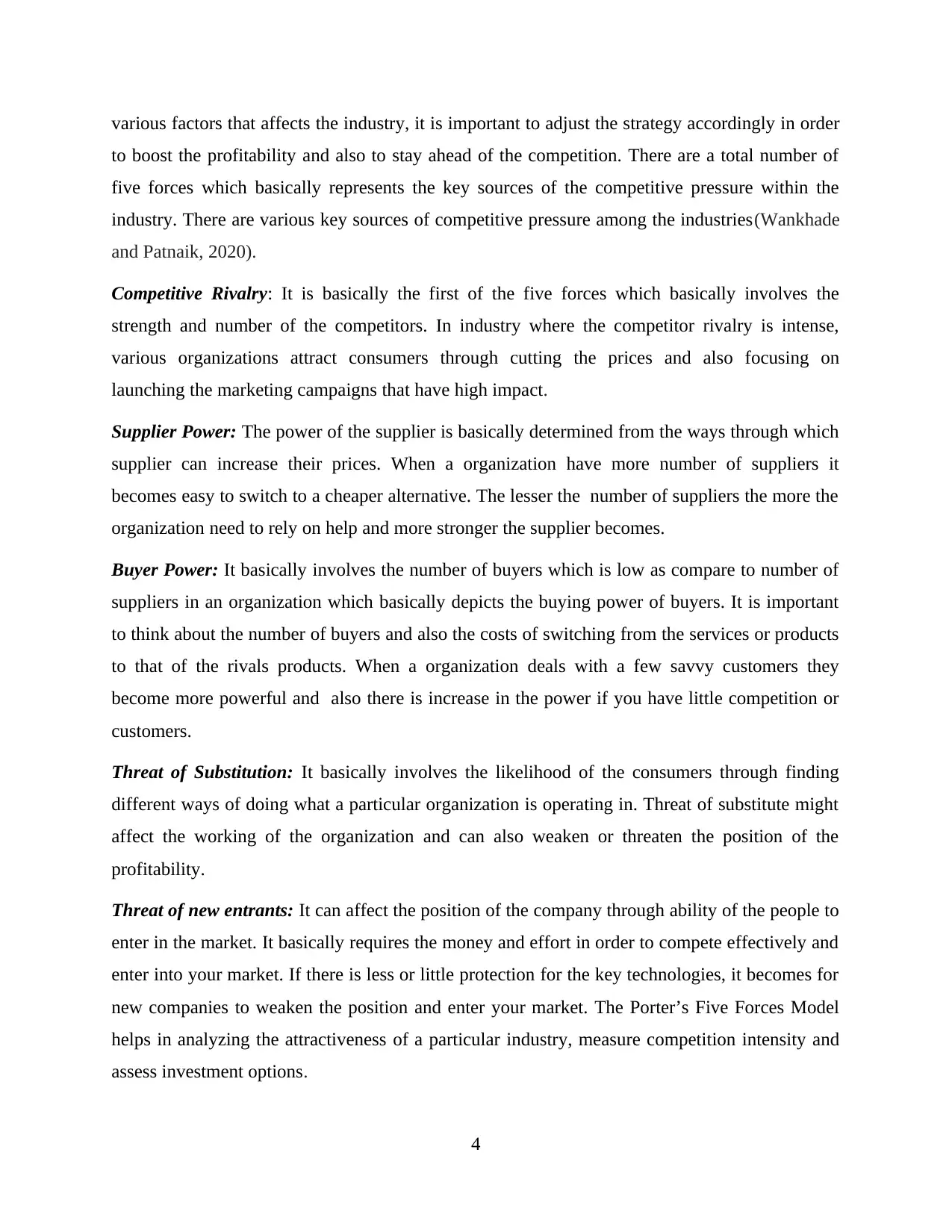
various factors that affects the industry, it is important to adjust the strategy accordingly in order
to boost the profitability and also to stay ahead of the competition. There are a total number of
five forces which basically represents the key sources of the competitive pressure within the
industry. There are various key sources of competitive pressure among the industries(Wankhade
and Patnaik, 2020).
Competitive Rivalry: It is basically the first of the five forces which basically involves the
strength and number of the competitors. In industry where the competitor rivalry is intense,
various organizations attract consumers through cutting the prices and also focusing on
launching the marketing campaigns that have high impact.
Supplier Power: The power of the supplier is basically determined from the ways through which
supplier can increase their prices. When a organization have more number of suppliers it
becomes easy to switch to a cheaper alternative. The lesser the number of suppliers the more the
organization need to rely on help and more stronger the supplier becomes.
Buyer Power: It basically involves the number of buyers which is low as compare to number of
suppliers in an organization which basically depicts the buying power of buyers. It is important
to think about the number of buyers and also the costs of switching from the services or products
to that of the rivals products. When a organization deals with a few savvy customers they
become more powerful and also there is increase in the power if you have little competition or
customers.
Threat of Substitution: It basically involves the likelihood of the consumers through finding
different ways of doing what a particular organization is operating in. Threat of substitute might
affect the working of the organization and can also weaken or threaten the position of the
profitability.
Threat of new entrants: It can affect the position of the company through ability of the people to
enter in the market. It basically requires the money and effort in order to compete effectively and
enter into your market. If there is less or little protection for the key technologies, it becomes for
new companies to weaken the position and enter your market. The Porter’s Five Forces Model
helps in analyzing the attractiveness of a particular industry, measure competition intensity and
assess investment options.
4
to boost the profitability and also to stay ahead of the competition. There are a total number of
five forces which basically represents the key sources of the competitive pressure within the
industry. There are various key sources of competitive pressure among the industries(Wankhade
and Patnaik, 2020).
Competitive Rivalry: It is basically the first of the five forces which basically involves the
strength and number of the competitors. In industry where the competitor rivalry is intense,
various organizations attract consumers through cutting the prices and also focusing on
launching the marketing campaigns that have high impact.
Supplier Power: The power of the supplier is basically determined from the ways through which
supplier can increase their prices. When a organization have more number of suppliers it
becomes easy to switch to a cheaper alternative. The lesser the number of suppliers the more the
organization need to rely on help and more stronger the supplier becomes.
Buyer Power: It basically involves the number of buyers which is low as compare to number of
suppliers in an organization which basically depicts the buying power of buyers. It is important
to think about the number of buyers and also the costs of switching from the services or products
to that of the rivals products. When a organization deals with a few savvy customers they
become more powerful and also there is increase in the power if you have little competition or
customers.
Threat of Substitution: It basically involves the likelihood of the consumers through finding
different ways of doing what a particular organization is operating in. Threat of substitute might
affect the working of the organization and can also weaken or threaten the position of the
profitability.
Threat of new entrants: It can affect the position of the company through ability of the people to
enter in the market. It basically requires the money and effort in order to compete effectively and
enter into your market. If there is less or little protection for the key technologies, it becomes for
new companies to weaken the position and enter your market. The Porter’s Five Forces Model
helps in analyzing the attractiveness of a particular industry, measure competition intensity and
assess investment options.
4
Paraphrase This Document
Need a fresh take? Get an instant paraphrase of this document with our AI Paraphraser
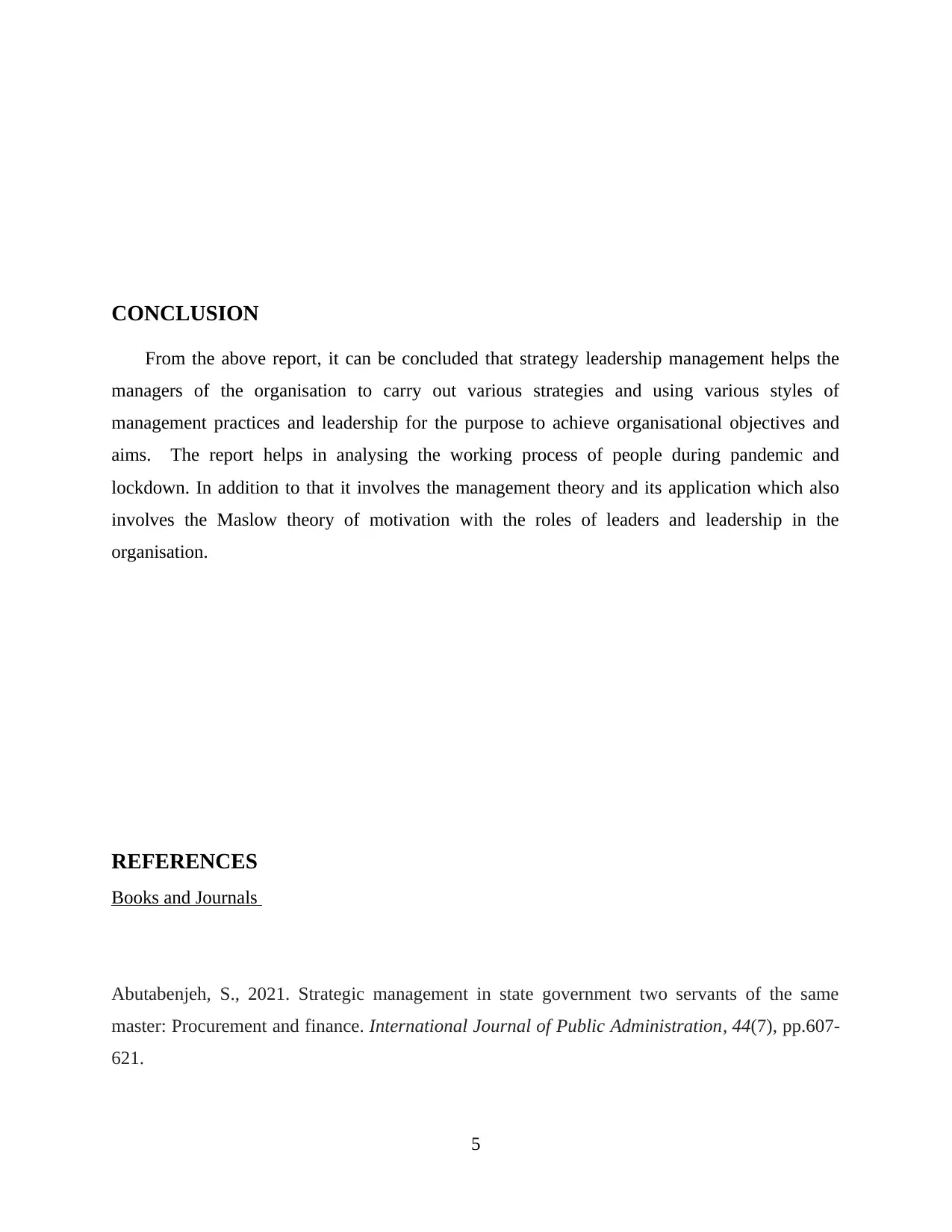
CONCLUSION
From the above report, it can be concluded that strategy leadership management helps the
managers of the organisation to carry out various strategies and using various styles of
management practices and leadership for the purpose to achieve organisational objectives and
aims. The report helps in analysing the working process of people during pandemic and
lockdown. In addition to that it involves the management theory and its application which also
involves the Maslow theory of motivation with the roles of leaders and leadership in the
organisation.
REFERENCES
Books and Journals
Abutabenjeh, S., 2021. Strategic management in state government two servants of the same
master: Procurement and finance. International Journal of Public Administration, 44(7), pp.607-
621.
5
From the above report, it can be concluded that strategy leadership management helps the
managers of the organisation to carry out various strategies and using various styles of
management practices and leadership for the purpose to achieve organisational objectives and
aims. The report helps in analysing the working process of people during pandemic and
lockdown. In addition to that it involves the management theory and its application which also
involves the Maslow theory of motivation with the roles of leaders and leadership in the
organisation.
REFERENCES
Books and Journals
Abutabenjeh, S., 2021. Strategic management in state government two servants of the same
master: Procurement and finance. International Journal of Public Administration, 44(7), pp.607-
621.
5
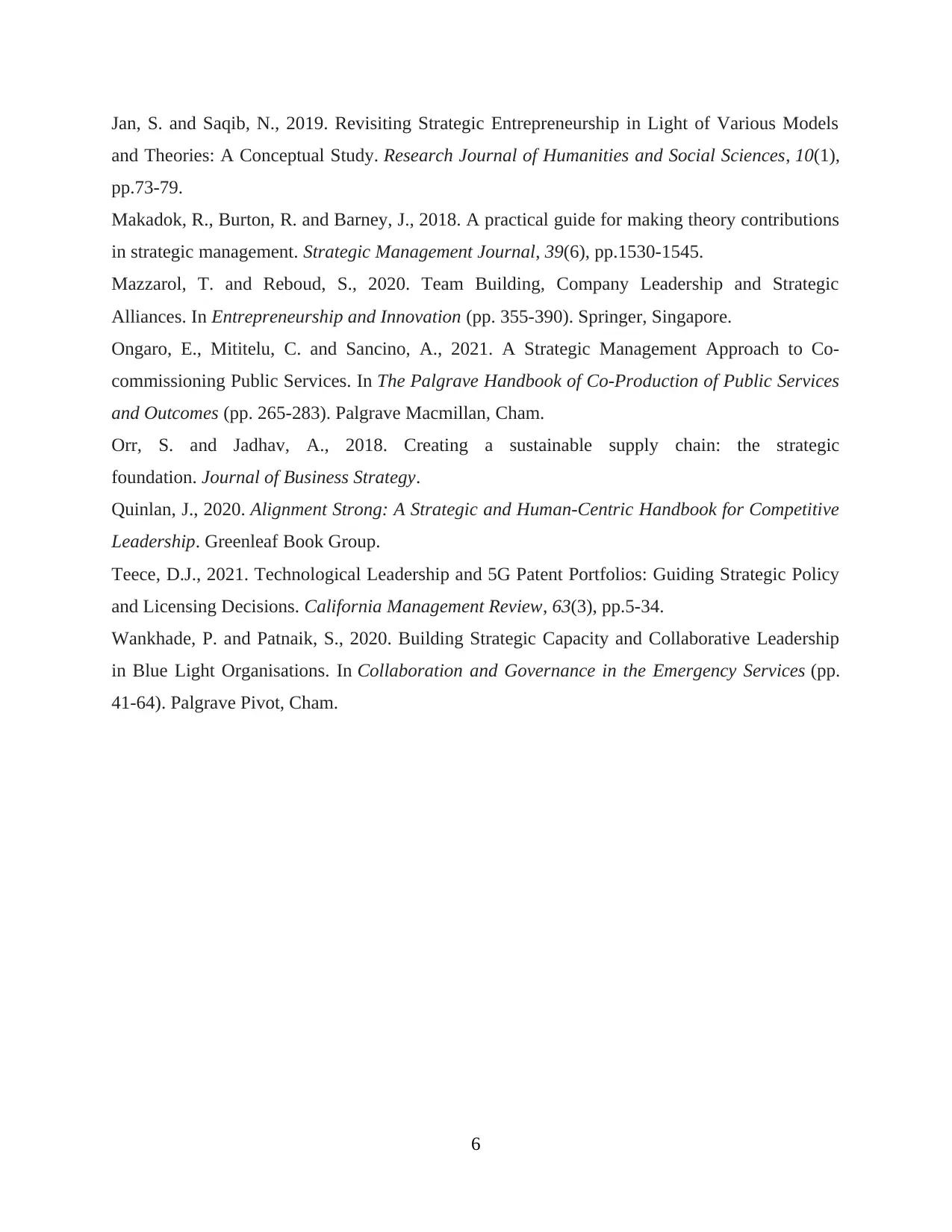
Jan, S. and Saqib, N., 2019. Revisiting Strategic Entrepreneurship in Light of Various Models
and Theories: A Conceptual Study. Research Journal of Humanities and Social Sciences, 10(1),
pp.73-79.
Makadok, R., Burton, R. and Barney, J., 2018. A practical guide for making theory contributions
in strategic management. Strategic Management Journal, 39(6), pp.1530-1545.
Mazzarol, T. and Reboud, S., 2020. Team Building, Company Leadership and Strategic
Alliances. In Entrepreneurship and Innovation (pp. 355-390). Springer, Singapore.
Ongaro, E., Mititelu, C. and Sancino, A., 2021. A Strategic Management Approach to Co-
commissioning Public Services. In The Palgrave Handbook of Co-Production of Public Services
and Outcomes (pp. 265-283). Palgrave Macmillan, Cham.
Orr, S. and Jadhav, A., 2018. Creating a sustainable supply chain: the strategic
foundation. Journal of Business Strategy.
Quinlan, J., 2020. Alignment Strong: A Strategic and Human-Centric Handbook for Competitive
Leadership. Greenleaf Book Group.
Teece, D.J., 2021. Technological Leadership and 5G Patent Portfolios: Guiding Strategic Policy
and Licensing Decisions. California Management Review, 63(3), pp.5-34.
Wankhade, P. and Patnaik, S., 2020. Building Strategic Capacity and Collaborative Leadership
in Blue Light Organisations. In Collaboration and Governance in the Emergency Services (pp.
41-64). Palgrave Pivot, Cham.
6
and Theories: A Conceptual Study. Research Journal of Humanities and Social Sciences, 10(1),
pp.73-79.
Makadok, R., Burton, R. and Barney, J., 2018. A practical guide for making theory contributions
in strategic management. Strategic Management Journal, 39(6), pp.1530-1545.
Mazzarol, T. and Reboud, S., 2020. Team Building, Company Leadership and Strategic
Alliances. In Entrepreneurship and Innovation (pp. 355-390). Springer, Singapore.
Ongaro, E., Mititelu, C. and Sancino, A., 2021. A Strategic Management Approach to Co-
commissioning Public Services. In The Palgrave Handbook of Co-Production of Public Services
and Outcomes (pp. 265-283). Palgrave Macmillan, Cham.
Orr, S. and Jadhav, A., 2018. Creating a sustainable supply chain: the strategic
foundation. Journal of Business Strategy.
Quinlan, J., 2020. Alignment Strong: A Strategic and Human-Centric Handbook for Competitive
Leadership. Greenleaf Book Group.
Teece, D.J., 2021. Technological Leadership and 5G Patent Portfolios: Guiding Strategic Policy
and Licensing Decisions. California Management Review, 63(3), pp.5-34.
Wankhade, P. and Patnaik, S., 2020. Building Strategic Capacity and Collaborative Leadership
in Blue Light Organisations. In Collaboration and Governance in the Emergency Services (pp.
41-64). Palgrave Pivot, Cham.
6
⊘ This is a preview!⊘
Do you want full access?
Subscribe today to unlock all pages.

Trusted by 1+ million students worldwide
1 out of 9
Related Documents
Your All-in-One AI-Powered Toolkit for Academic Success.
+13062052269
info@desklib.com
Available 24*7 on WhatsApp / Email
![[object Object]](/_next/static/media/star-bottom.7253800d.svg)
Unlock your academic potential
Copyright © 2020–2025 A2Z Services. All Rights Reserved. Developed and managed by ZUCOL.




